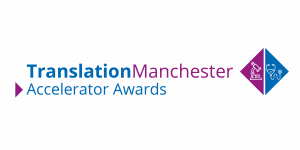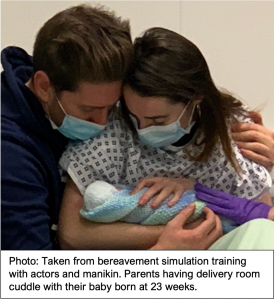
Access to Expertise (A2E) Awardees 2023

In 2023, Translation Manchester ran the Translation Manchester Accelerator Awards (TMAA) call, which brought together funding from the Wellcome Translational Partnership Award (TPA), the NIHR Manchester Biomedical Research Centre (BRC) and the UKRI MRC Impact Accelerator Account (2022-25).
This funding call included two schemes; Confidence for Translation (C4T) and Access to Expertise (A2E). The A2E scheme provided up to £25,000 for researchers to access expertise external to their research group to overcome translational bottlenecks.
The call was extremely competitive with a great number of high quality proposals received for consideration. After thorough peer review the following A2E projects were funded through the Wellcome TPA and the NIHR Manchester BRC Next Generation Therapeutics theme:
Brian Bigger
Analysis of lentiviral vector integration sites in stem cell gene therapy for Sanfilippo disease type IIIB
£21,500
Jennifer Peterson
Information Resource for Parents facing Periviable Delivery
£11,080
Neil Roberts
Economic feasibility of gene therapy for early onset bladder disease
£7,441
Paul Nutter
Hypoglycemia T1DM-NICE Accelerator
£23,084
Richard Unwin
Generation of validated standards for accurate measurement of the complementome in clinical samples
£25,000
Silke Brix
Creation of the ARRS23 Software to Allow the Routine Use of the Prediction Tool in Clinical Practice
£24,895
These studies join our strong portfolio of translational research projects, spanning across the full translational pathway, which we are currently supporting in order to facilitate their journey towards patient benefit.
A lay summary for each project can be found below:
Brian Bigger
Analysis of lentiviral vector integration sites in stem cell gene therapy for Sanfilippo disease type IIIB
Sanfilippo disease is a devastating childhood genetic disease caused by a missing enzyme. In a healthy person, the NAGLU enzyme breaks down complex sugars, such as Heparan Sulphate (HS). In affected patients, an absence of NAGLU leads to the accumulation of HS to toxic levels causing cells to malfunction. The brain is most severely affected, with distressing clinical outcome. Diagnosed between 2-4 years of age, MPSIIIB children are hyperactive, with a deteriorating mental and physical state over several years. Patients typically do not survive past their late teens and there are currently no available treatments.
In order to deliver NAGLU to the brain where it is needed most, we have developed a stem cell gene therapy approach. This technique replaces the missing NAGLU gene in bone marrow stem cells from an affected patient using a disabled viral vector to deliver NAGLU into cells. After transplant of gene modified bone marrow back into patients, bone marrow stem cells are able to make every blood cell in the body. Monocyte cells in the transplanted bone marrow traffic to the brain, where they engraft and deliver enzyme to bystander cells. In pre-clinical proof-of-concept studies we have proved the effectiveness of this approach by successfully treating MPSIIIB mice, demonstrating correction of the brain for the first time.
To progress to starting a company with this work we need to generate further data on the places in the patients genome where our disabled viral vector integrates. This provides valuable safety information on this stem cell gene therapy approach. As such, Protagene (formerly genewerks) is able to perform this complex analysis for us to enable us to move forward into clinical trial. This analysis is essential prior to moving this therapy into patients.
Jennifer Peterson
Periviable Birth: Development of a Parent-Informed Information Resource
Background
Every year across England and Wales there are 1000 babies born at the edges of viability (from 22+0 – 24+6 weeks gestation). Birth within this periviable period is fraught with ethical and emotional issues and poses many difficult decisions for parents and clinicians to navigate. Survival and developmental outcomes after periviable birth are highly variable and therefore, there is a decision to be made about whether active, survival focused intensive care should be implemented at birth or whether comfort care is more appropriate, in which case the infant should be held by their parents after birth and allowed to die in their parents’ arms in the delivery room. Making these complex decisions is extremely difficult for all involved.
The ALLIANCE Study
Our research team conducted a study at Manchester University NHS Foundation Trust (MFT) which explored the difficulties parents and clinicians encounter making these decisions. This study was called ALLIANCE (PeriviAble DeLiveries: ALIgning PArental aNd PhysiCian PrioritiEs) and has identified that a key issue in current practice is the level of variation in what information and which management options are presented to parents by clinicians. Variation in information shared in this context limits the parents’ ability to make fully informed decisions and can directly impact the choices they make for the care of their infant at birth.
Empowering Parents
There is currently no specific information resource for parents facing periviable delivery. Through the ALLIANCE study we know that parents who have experienced periviable delivery would welcome a parent-specific resource (100% of parents involved in the ALLIANCE study). This A2E funding will enable us to build a useful, parent-informed web-based resource which can be accessed easily by parents facing periviable delivery and the clinicians that treat them across the UK.
Contact:
Jennifer Peterson, ALLIANCE researcher and Neonatal Doctor at St Mary’s, Manchester.
Neil Roberts
Economic feasibility of gene therapy for early onset bladder disease
Rare conditions collectively affect around 7% of the population. Many have defined genetic bases, but very few have definitive cures. Now, technological advances and clinical approvals have led to an explosion of investment in and development of molecular therapies for previously incurable genetic conditions. In this project we will explore the economic feasibility of taking to clinical use a gene therapy for the rare early-onset bladder disease urofacial syndrome. There are no cures for this disease, which requires chronic and invasive treatment and can progress to kidney failure. Our exciting preclinical trials in mice have demonstrated remarkable efficacy of virus-based gene therapy. To be able to bring this therapy to the clinic, it is crucial we have a comprehensive understanding of the health economics of both urofacial syndrome and gene therapies. This A2E project will fund dedicated time for our experienced Health Economist (Dr Sean Gavan) to evaluate the health care burden and costs associated with urofacial syndrome and place these in the context of costs associated with development and clinical use of a gene therapy. This health economic evidence is vital to move us one step closer to benefitting patients and securing follow-on external funding to translate our promising gene therapy for individuals who are currently facing substantial unmet need.
Paul Nutter
Hypoglycemia T1DM-NICE Accelerator
Congenital Hyperinsulinism (CHI) is a condition that causes exceptionally low blood glucose (hypoglycaemia) in children. The condition results in brain damage in up to 48% of those effected, costing the NHS in excess of £3.4million/year. The current medical management of CHI is insufficient to prevent hypoglycaemia and so methods of prevention of hypoglycaemia, such as utilising glucose monitoring and hypoglycaemia prediction, are required. The use of Continuous Glucose Monitors (CGMs) for blood glucose sensing has emerged as a method of hypoglycaemia prediction in other similar conditions, such as Type 1 Diabetes Mellitus (T1DM). However, this approach is undermined by poor sensing accuracy in patients with CHI and has failed to demonstrate any real-world reduction in hypoglycaemia events in CHI patients.
We have developed an alternative approach, supported by a software prototype, which, when tested in pilot studies, reduces hypoglycaemia ‘hotspots’ by 67% and total hypoglycaemia events by 25% in patients with CHI. To facilitate our translation from CHI to T1DM, and to support the larger clinical studies required for this larger population, we need to scale our work so that it can make use of Flash Glucose Sensing devices; a type of glucose monitoring device expected to be used by the majority of the T1DM population due to their significantly lower cost compared to CGM. In this case we need to re-engineer the prototype to include support for new sensing devices, beyond CGM, and make the application scale to a much larger cohort. Simply, we need to extend the system to include new third-party technologies that are key to supporting NHS efforts to provide glucose sensing for all people with T1DM. This application will do just that.
Richard Unwin
Generation of validated standards for accurate measurement of the complementome in clinical samples
We have shown in the laboratory that changes in a set of proteins which control a key part of the immune system, called the complement cascade, can play an important role in predicting whether a person may develop particular diseases, or how severe they are. In particular, we have shown that when an individual contracts COVID-19, the higher the levels of these protein, the more severe their symptoms – those with the highest levels being those most likely to require hospitalisation and ventilation. In independent experiments, we have also shown these proteins to be important in the risk of developing age-related macular degeneration, and in predicting the response of patients with glioblastoma to certain drugs.
To measure the levels of a protein in the blood accurately, one needs a ‘standard’ – that is a version of that protein where you know the amount, and you can compare the results from the standard to those from a patient sample to calculate the amount present in the patient. Proper standards are also vital for translating these measurements into the clinical environment, where multiple labs all need to use the same standard, and you have to be certain that the standard does not change (e.g. degrade) over time so that results from many people from many labs over time can be reliably compared.
In this project, we will design, prepare and characterise the required standards to allow us to measure these important proteins in larger patient groups and between laboratories. Working with the National Physical Laboratory, the UKs national standards and measurement agency, we will make and accurately quantify our reagents against international standards, and perform a series of experiments so that we know how to prepare, store, and use these standards to give us accurate patient measurements. This is a critical stepping stone supporting translation to the clinic.
Silke Brix
Creation of an ARRS23 Software to Allow the Routine Use of the Prediction Tool in Clinical Practice
We created a tool that helps to predict kidney failure in ANCA vasculitis so that patients and health professionals understand the risk of the patient needing dialysis. The tool was designed to assist patients and physicians to jointly decide what the best treatment option is for the individual.
Vasculitis is a term used to describe a group of rare diseases that inflame and damage blood vessels. ANCA are antibodies found in the blood. Kidneys are often affected by vasculitis and can scar undetected for months or be quickly destroyed within days. Untreated, vasculitis is fatal.
Strong medication from cancer care is used to treat ANCA vasculitis and side effects are common. Patients are susceptible to infections and are three-times more likely to die of an infection than from vasculitis.
We created the original tool called the ANCA renal risk score (ARRS) in the years 2010-2016. This score uses blood and tissue results. We tested it around the world and it was found to accurately tell when kidneys stop working. We then collected over 1500 patients with the rare disease to create an updated and optimised version, the ARRS23.
First, the Access to Expertise (A2E) grants allowed us to work together with statisticians from the University of Manchester to create the updated version of the tool. Now, it enables us to design the website. The team around Charlotte Stockton-Powdrell from the design service of the University will build a webpage for patients and health professionals around the world to easy access and use. Our patient and public engagement group has six people living with ANCA vasculitis and their relatives. This group will help to create the ARRS23 website in a way that patients will find it most useful.






0 Comments